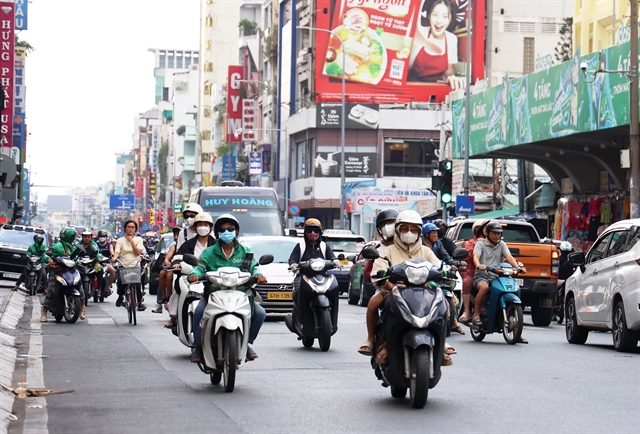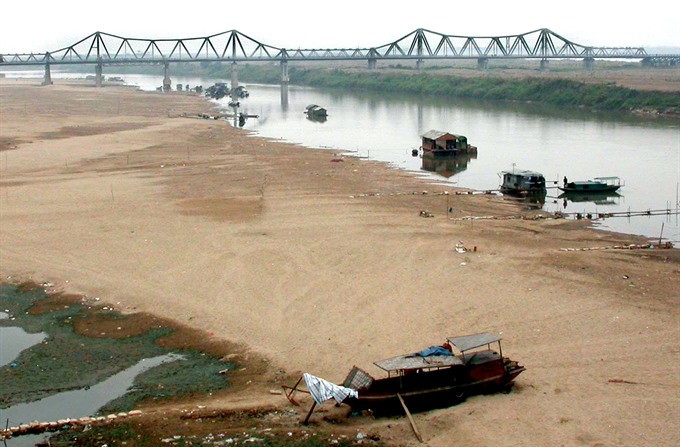 Environment
Environment

The average water level of many parts of the Hồng (Red) river has remarkably reduced in recent years, badly affecting agricultural production and the living conditions of residents in the northern low-land and midland areas.
 |
| A section of the Hồng (Red) River running under Hà Nội’s Long Biên Bridge has dried up. The average water level of the river had dropped remarkably in recent years, affecting both agricultural production and the daily lives of local residents.— VNS Photo Đoàn Tùng |
HÀ NỘI – The average water level of many parts of the Hồng (Red) river has remarkably reduced in recent years, badly affecting agricultural production and the living conditions of residents in the northern lowland and midland areas.
The level in some sections is two metres lower than the previous 20 years. The level in some parts reached the lowest point of 2.2m, causing difficulties for irrigation work, said experts at a conference held in Hà Nội on Wednesday to assess the impact of lower Hồng River water levels and to discuss solutions.
The lower level makes it hard for pumping stations to provide water for agricultural production.
According to Hà Đức Trung, Deputy Director of the Hà Nội’s Department of Agriculture and Rural Development, irrigation systems along the river were built a long time ago, when the water level was still high. But now many pumping stations cannot operate because the water is too low. Phù Sa pumping station in Hà Nội’s Sơn Tây Commune, for example, was designed to meet water levels of 5.2m but the water level of Hồng River flowing through the commune now only reaches 4.8m.
To ensure enough water for 630,000ha of rice of 12 localities in the midland and lowland areas, the Ministry of Agricultural and Rural Development has annually co-operated with the Electricity of Việt Nam to take water from hydropower reservoirs as a supplement.
Lower water levels have not only deprived farmlands but also caused problems with waterway transport.
Experts at the conference said there are two main reasons leading to the reduction of the water level, including depression of the river bottom and excessive sand exploitation.
As estimated, the release of around 5 billion cu.m of water for the winter-spring crops in 20 days has impacted the depression of the river bottom. Meanwhile, around 33 million cu.m of sand is exploited each year, lowering the river-bed and decreasing the water level.
The low rainfall in the northern region in recent years has worsened the problem, they said.
Deputy Minister of Agriculture and Rural Development Hoàng Văn Thắng said the reduction of the water level of Hồng river over the past years badly affected agricultural production and daily activities of residents.
The Red River passes through Hà Nội and 25 other provinces in the north with a population of 26 million people and total agricultural area of nearly 1.1 million hectares.
Thắng urged the Việt Nam Academy for Water Resources to promptly review the situation, particularly the depression of the river bottom and sand exploitation to report to the Government and relevant ministries to have appropriate solutions.
Relevant agencies were assigned to take measures such as using sand to raise the river bottom to help increase the water level and actively prepare plans to supply enough water for agricultural production and daily activities of local residents, he said.
Professor Hà Văn Khối, former lecturer of the Hà Nội-based University of Water Resources, said one important measure would be to better manage the operation of reservoirs upstream to reduce the level of river bed erosion.
Other participants said the river flow changes should be taken into consideration. Irrigation works, pumping stations and dam systems in Hà Nội no longer meet the current situation of the Hồng river. The irrigation system was downgraded as many pumping machines were built since 1960 and reached about 70 per cent of their performance.
They pointed to the need to build new facilities or upgrade existing ones to make them operate more effectively.- VNS




